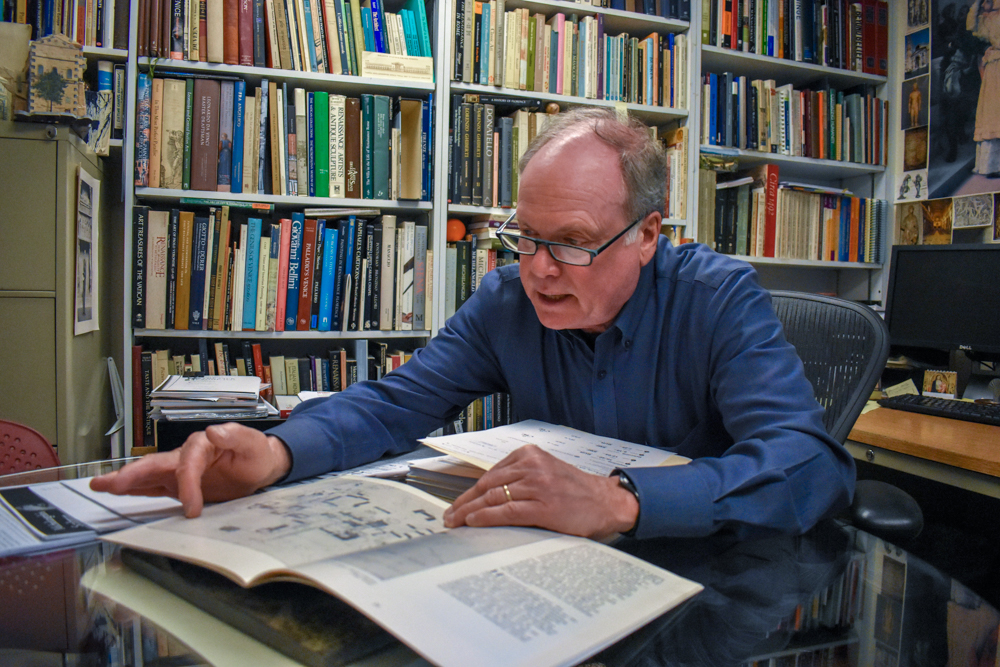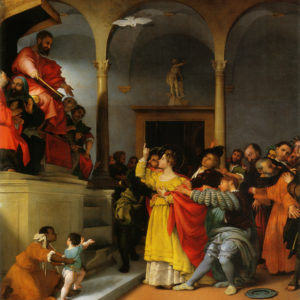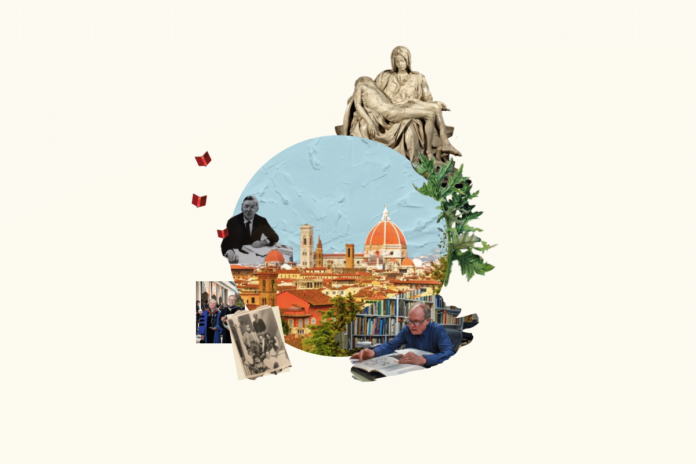Professor Eric Frank’s office embodies his decades of teaching at Occidental College. Floor-to-ceiling bookcases line his walls, filled with the colorful bindings of art history books. The occasional trinket is tucked into the spaces between: a Vin Scully bobblehead, a plastic orange stress ball, a painted wooden ornament. Assorted prints of European art, like the floor plan of a Roman basilica, decorate the remaining wall space. As he works, he looks up from his desk to a wall full of postcards students have sent him. Frank sits with visitors during office hours at a round table supported by a miniature replica of a Corinthian column, a nod to the Ancient Greek pillars that feature intricately-carved scrolls and acanthus leaves. Physically, the office is small. But its collection of volumes, prints and keepsakes — collectively representing hundreds of years of art history — makes the room feel vast.
Frank will retire in Summer 2021, concluding a 35-year-long career at Occidental. Throughout that time, he taught classes in the art and art history department on the classical tradition in Western art, his specialty being the Italian Renaissance. Frank also worked as an administrator, acting as associate dean of the college from 2003–2005 and dean of the college and vice president for academic affairs from 2005–2010. By the end of his career, Frank will have seen three decades, eight college presidents and hundreds, if not thousands, of students.

“A kid growing up on Long Island who had never been to a museum”
At 19 years old, Eric Frank had no idea what he wanted to do with his life. A Long Island native, he knew he liked to go to museums — casually, Frank said, the same way lots of people like to go to museums. He had never taken an art history class before. It wasn’t until he enrolled in a 10-week study abroad program in Florence, Italy, during his sophomore year at Dartmouth College, that he discovered his interest might not be a casual one.
In Florence, Frank was taught by art historian Eve Borsook. He assisted conservator Leonetto Tintori in restoring frescos — mural paintings created using water-based pigment and plaster — that had been damaged in the devastating 1966 flooding of Florence’s Arno River. Frank said while he did a little bit of restoration himself, he mostly watched Tintori work.
“I completely fell in love with not only the nature of Florentine art, but Italian culture in general,” Frank said. “I came back in the spring term of my sophomore year and declared an art history major, much to the consternation of my parents.”
Frank graduated in 1974 as Dartmouth’s only art history major. After taking a gap year, he applied for and received one of four full-ride fellowships offered by Syracuse University’s Masters in Italian Renaissance Art program, where students spend most of their time studying in Florence. One of the fellows he met on the Syracuse program was Penni Montalbano, a student from New Jersey who would later become Frank’s wife. The couple have two sons.
Frank went on to earn a doctorate in Italian Renaissance Art from New York University’s Institute of Fine Arts. When he applied for admission, he knew he wanted to study under Sir John Pope-Hennessy, a renowned Italian Renaissance art scholar and museum director who was teaching at the Institute. Frank remembers Pope-Hennessy as very English, and very demanding. One of Frank’s favorite books on his office bookshelves, Pope-Hennessy’s “Italian High Renaissance and Baroque Sculpture,” features a line on its dedication page where Pope-Hennessy expresses his indebtedness to Frank for his help.
Frank said in his own first few years of teaching — first at the University of California, Berkeley, then Middlebury College in Vermont — he remembers going up in front of the classroom and not hearing the lecture in his own voice, but the voices of past professors: Pope-Hennessy, his second dissertation reader, and all the other professors who taught him.
“All of these teaching voices are rolling around your head, and the key is to get them away and to have your voice. And that took me about three years, I would say,” Frank said. “It’s a good thing, because it means that you have somebody that has been, or is being, very influential on your learning experience and your life. I hope that my students over the years have gotten up, and heard my voice, and gotten over me, too.”
Frank knows of seven former students who have pursued art history masters programs, two of whom went on to earn art history doctorates. Stephanie Schrader ’90, curator of drawings at the J. Paul Getty Museum, was one of Frank’s first students when he arrived at Occidental in 1986. This year, she returned to Occidental to teach the Fall 2019 ARTH 391 course, a curatorial seminar.
Emails, meetings and broken biology refrigerators
In addition to his faculty role, Frank spent seven years of his Occidental career working in the college’s administration. He first acted as an associate dean before assuming the role of dean of the college in 2005. For him, it was the unpredictability of life as an administrator that made it different from life as a faculty member.
“It’s a very complicated job. Imagine having to answer 150 emails a day — where people want you to answer them. It’s like that every day of the year, 365 days a year,” Frank said. “Sometimes, you have to work three-and-a-half weeks straight, including Saturday and Sunday, because there are alumni events or trustee events. And there were times when I was in that office that I didn’t even know what day of the week it was.”
According to Frank, unpredictability brought with it an array of administrative tasks: negotiating with prospective faculty hires, coordinating with Facilities after refrigerators carrying biology department specimens broke down, looking for funding that could support new programs. For example, Frank recalled a day when Politics professors Peter Dreier and Regina Freer came to his office with a proposal for a new program: Campaign Semester.
“I remember going into the CFO’s office at the time, and he said to me, ‘Well, you can do whatever you want to do, but are you going to pay for it?’ And I said to him, ‘Well, you’re going to help me pay for it,'” Frank said. “That’s the good thing about the job and the bad thing about the job. Things can happen — you make a decision that enhances the institution — or things happen that you have to deal with that could be bad for the institution.”
Professor Irene Girton of the music department worked alongside Frank when she was associate dean for arts and humanities from 2005–2014. Girton and Frank will retire at the same time, Summer 2021, and plan to host a shared retirement party to celebrate. She said one of Frank’s most notable characteristics as a dean was his intense interest in every faculty member’s work, regardless of discipline. Girton also admired Frank’s humanity and optimism — in the face of endless meetings — above all else.
“He’s a 360-degree human being while he does his work. He doesn’t save his humanness for outside of the regular working hours,” Girton said. “He showed me, through the way he spoke to people, the way he explained his actions, not how to make people feel particularly good about getting a ‘no,’ but how to say ‘no’ in such a way that it made sense, that it seemed fair, and without cutting off all hope for the future.”
Frank said he made sure to teach at least one art history course each year he worked as an administrator. Sometimes, it was ARTH 170, “Introduction to Early European Art,” Frank’s favorite course to teach. He said he enjoys ARTH 170 most because it lets him introduce Occidental students, many of whom have never taken an art history class, to a completely new discipline. Frank said the average ARTH 170 class size is around 45 students, and he has taught it 32 times.
Returning to the classroom, for good
Frank’s time as dean of the college concluded in 2010, and after a year-long break, he returned to full-time teaching. In the current Fall 2019 semester, Frank teaches his fourth round of ARTH 373, “Michelangelo: Art and Biography.” Students enrolled in ARTH 373 study Michelangelo Buonarroti, the famed Italian artist who created the Sistine Chapel ceiling, the Vatican Pietà and David. At the end of the semester, Frank and his students fly to Italy to visit Florence, Siena, Orvieto and Rome for two weeks. When he was first developing the class, Frank said it was important to him that any student could enroll in ARTH 373 and fly to Italy, regardless of financial circumstances. He credits Robin Craggs, executive director of the International Programs office, and Jorge Gonzalez, then dean of the college, for ensuring the trip’s accessibility to students.
Erika Schell ’19 is one of the 80 students who have traveled to Italy in past years as part of Frank’s ARTH 373. She first met Frank in ARTH 170, and she remembers his support, guidance and encouragement most.
“His ability to teach with excitement and concision really made me love and understand art history in a way I hadn’t before,” Schell said via email. “I remember other tourists following our group around churches or museums to catch Professor Frank’s explanations and observations about the art and architecture.”
Above his office desk, Frank has around 40 postcards individually taped onto the wall. The postcards are the kinds available for purchase in museum gift shops, each one featuring a single art piece on display in a particular museum’s collection. Collectively, the postcards create a collage of historic sculptures, paintings, vases and buildings. Some art pieces appear more than once, across multiple postcards. Frank said these postcards were sent to him over the years by former students who visited museums and saw, in person, the art pieces Frank once lectured about.
Mark Pabst (senior), an art history major who has taken a class with Frank every semester since his first year at Occidental, said Frank’s lecture style is one of the reasons he enjoys Frank’s classes so much. His lectures, Pabst said, follow the traditional, old-fashioned art history style: art-in-the-darkness, darkness-at-noon.
“You go in the room, you sit down, he shows you the images, he tells you the things, you write the things down, and then you take the test,” Pabst said. “And it’s very orderly, it’s controlled, it’s structured — but it’s not emotionless.”
Students point to Frank’s emotion, both inside and outside the classroom, as one of his defining qualities as a professor. Pabst said Frank’s care for students beyond a passing greeting outside of class is one of Frank’s standout traits. Isabel Norsten (senior), another art history major, feels similarly. Outside of class time, Frank’s office door is always open, Norsten said. During class time, he makes learning pure, joyful and celebratory.
“For me, I feel my passion [was] accelerated by his care for me as a student and his investment in our class and our class dynamic. And everything is just all relational: one person gets excited about something because he’s excited about something, and then the whole class is excited about something,” Norsten said. “He doesn’t make school some scary thing. It’s not something to be conquered or to get an ‘A’ at. It’s a thing to get better at because you care about improving yourself, or because you care about being curious about the world.”
Frank said that while the life of someone in the humanities cannot be planned, he hopes through conversations in office hours or classroom lectures he has been able to help students find their own unique interests and take risks.
“I see an undergraduate liberal arts professor’s responsibility not only to enhance the academic experience that one has in class, but also to talk to students broadly about their lives and how I can help mentor them into thinking about what they want to do,” Frank said. “Not professionally, necessarily — sometimes — but how they want to live their lives, or what kind of life they want to have, or what is the character of a happy life.”
1986 vs. 2019: Timeless art, changing students
With over three decades at the college and hundreds of Occidental students passing through his classroom, Frank has been able to observe changes in the student culture over time. One example of a change, Frank said, is in the topics students push him on during class. Turning to his computer, Frank opens an image of “The Hunters in the Snow,” a 1565 oil painting by Pieter Bruegel, a Dutch and Flemish Renaissance painter. “Hunters in the Snow” depicts a winter landscape of snow-covered houses, trees and mountains. In the bottom-left corner, a weary band of peasants and their hunting dogs trudge over a hill, somber after an unsuccessful hunt. Frank traces a finger from the peasant band to the valley town they overlook. He explains that Bruegel’s paintings largely featured peasants but were commissioned by wealthy aristocrats. For his students, that prompts a larger question: Why did the rich want paintings of the poor? Despite the 1565 painting remaining the same, Frank said today’s students engage with this question of class tension in a different way.

“If I taught that material 35 years ago, it would be just another theme. But if I teach the material now, it’s something that is central to what students think about in their own lives,” Frank said. “So the social justice component of that? Not too important for somebody in 1986. But the social justice implications of that now? Critical.”
The shifts in how students challenge him over time make him think about class material in a more focused, socially-responsible way, Frank said. Those changes considered, some things have stayed the same. Despite having taught his favorite course, ARTH 170, 32 times, Frank said he still feels nervous every time he walks into the classroom on the first day of class. But to him, that feeling is essential.
“I am nervous before every class. And I think that’s a good thing. I mean, it goes away almost right away,” Frank said. “But I think if you don’t have that, then you’re doing something wrong. You’re not all in for the students and for your material. You should teach thinking that every class, you’re talking about something that is the most important thing in the world.”

The 40 or so postcards taped to Frank’s office walls share the space with a poster-sized print of the 1532 Lorenzo Lotto painting, “St. Lucy before the Judge.” In the center of the painting stands an impassioned St. Lucy, who Frank describes as asserting a firm, independent position before a judge’s bench at a time when a woman arguing for her independence would mean certain death. St. Lucy faces the judge and raises an arm, pointing to the sky, while a man attempts to hold her back by gripping her other arm. Frank said he has had the poster up since he moved into the office, and it is an image that has stuck with him since graduate school.
“In a way, I kind of think that that’s what an undergraduate education is: that you need to graduate being able to assert an independent position that you’re sure of,” Frank said. “That’s not the reason I put that up there, but over time, it’s become a kind of visual theme for what I do, what we all should do, what I aspire for my students to do in their lives after they graduate. To be like St. Lucy. And just speak up, and don’t be afraid, and assert yourself.”
![]()



































